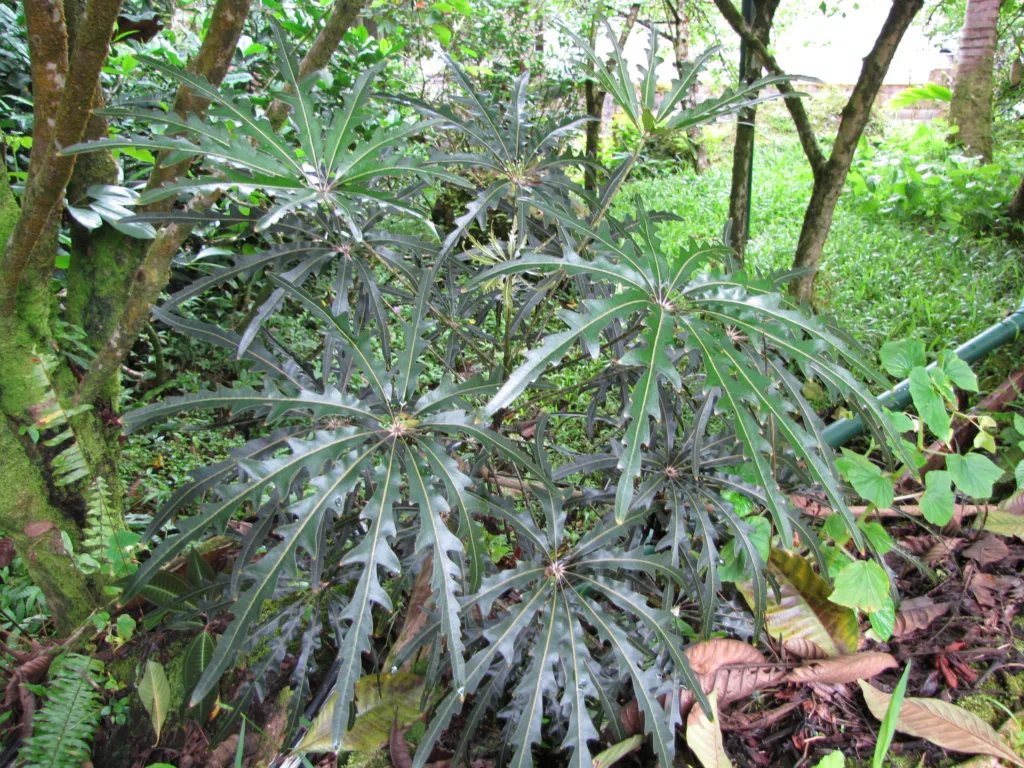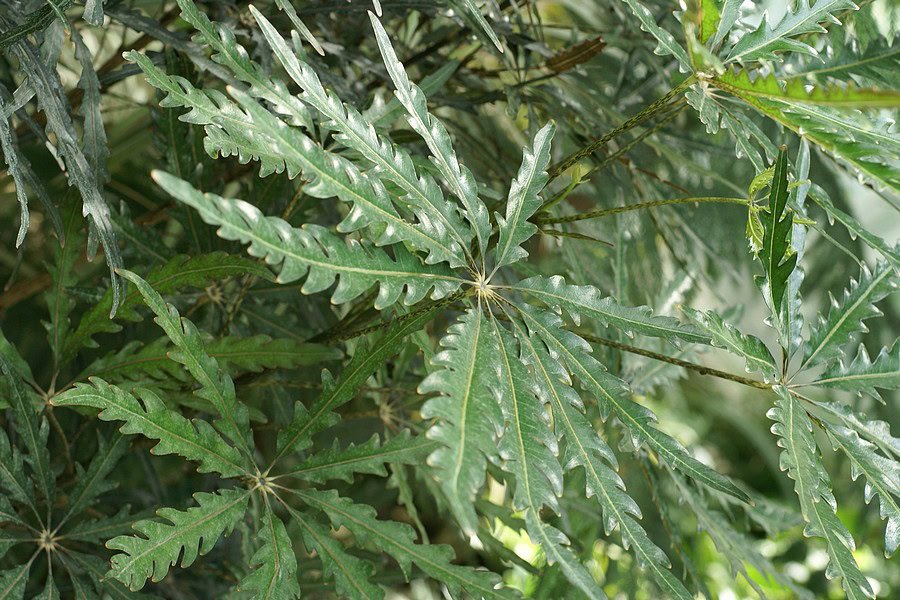Aralia, also known as Scheffler Elegantissima or Dizygotheca Elegantissima, is a beautiful and popular houseplant that adds a touch of elegance to any indoor space.
With its glossy foliage and intricate leaf patterns, False Aralia is a favorite among plant enthusiasts. If you’re new to caring for this exotic plant or simply looking for some expert advice, you’ve come to the right place.
Aralia is also known for its lush green, finely divided, palm-shaped leaves. The leaves are usually dark green, and each leaf has serrated edges.
In this comprehensive guide, we’ll explore everything you need to know about growing and maintaining false aralia, from selecting the perfect location to tackling common challenges along the way.
| Feature | Details |
|---|---|
| Common Name | False Aralia |
| Scientific Name | Schefflera elegantissima |
| Family | Araliaceae |
| Native Region | New Caledonia |
| Foliage | Finely divided, palmate leaves |
| Leaf Characteristics | Dark green with serrated edges |
| Growth Habit | Multi-stemmed shrub, upright |
| Size | Can reach several feet in height |
| Light Requirements | Bright, indirect light |
| Watering | Keep soil consistently moist, allow top inch to dry between watering |
| Humidity | Prefers higher humidity levels |
| Temperature | 65-75°F (18-24°C), protect from drafts and sudden temperature changes |
| Soil | Well-draining, peat-based potting mix |
| Pruning | Prune to control size and shape, remove leggy or unhealthy growth |
| Toxicity | Generally not considered toxic to humans, but may cause mild irritation. Caution is advised. |

Choosing the Right Location for False Aralia
When it comes to the optimal location for your false aralia, there are a few key factors to consider. This tropical beauty thrives in bright, indirect light, so it’s important to find a spot in your home that receives plenty of filtered sunlight.
Avoid placing your plant in direct sunlight, as this can scorch its delicate leaves. However, too little light can also negatively impact its growth, so striking the right balance is crucial.
Moreover, false aralia is sensitive to temperature changes, especially cold drafts. Keep your plant away from doors and windows during the colder months to shield it from chilly gusts.
Ideally, the average temperature should range between 60 to 75 degrees Fahrenheit (15 to 24 degrees Celsius) for optimal growth.
Planting and Potting Mix for False Aralia
When it comes to planting your false aralia, it’s essential to choose the right potting mix. A well-draining mix consisting of equal parts peat moss, perlite, and coarse sand will provide your plant with a suitable environment.
This combination allows excess water to flow freely, preventing root rot and other water-related issues.
When selecting a pot size, opt for a container that is slightly larger than the root ball of your plant.
Avoid using a pot that is too big, as this can lead to waterlogged soil and hinder the plant’s growth. A pot with drainage holes is crucial for maintaining proper moisture levels.
Watering and Humidity for False Aralia
False aralia thrives in slightly moist soil, but overwatering can be detrimental to its health. Allow the top inch of soil to dry out between watering sessions.
Insert your finger into the soil and if it feels dry, it’s time to water your plant. When watering, pour water evenly throughout the pot until it starts to drain out of the bottom. Discard any excess water after a few minutes to prevent waterlogging.
Maintaining adequate humidity levels is essential for the well-being of your false aralia. This tropical plant enjoys higher humidity levels, so consider placing a humidifier nearby or misting the leaves regularly.
Alternatively, you can place a water-filled tray near the plant to increase the humidity in the immediate vicinity.
Fertilizing and Pruning for False Aralia
Proper fertilization is key to promoting healthy growth in false aralia. During the growing season, which typically spans from spring to summer, apply a balanced liquid fertilizer diluted to half the recommended strength.
Feed your plant every two to four weeks, ensuring it receives the necessary nutrients for optimal growth. However, avoid fertilizing during the winter months, as the plant is in a period of dormancy.
Regular pruning is an essential practice to maintain the aesthetic appeal of your false aralia and promote bushier growth.
Remove any dead or yellowing leaves by gently pinching them off at their base. If you notice leggy stems or growth that is becoming unruly, prune them back to encourage a fuller, more compact plant. Remember to use clean, sharp pruning shears to prevent the spread of diseases.

Troubleshooting Common Challenges for False Aralia
False aralia, like any other plant, may face certain challenges along the way. Here are some common problems and their solutions to ensure your plant thrives:
Yellowing Leaves
Yellowing leaves can be a sign of overwatering or inadequate drainage. Ensure your plant is not sitting in water and adjust your watering schedule accordingly. If the potting mix appears overly moist, allow it to dry out before watering again.
Brown Leaf Tips
Brown leaf tips are often an indication of low humidity levels or underwatering. Increase the humidity around your plant by misting the leaves or placing a tray of water nearby. Remember to water your plant thoroughly, allowing excess water to drain out.
Pests
False aralia is susceptible to common houseplant pests such as spider mites, aphids, and mealybugs. Regularly inspect your plant for signs of infestation, such as webbing, sticky residue, or small insects.
If detected, use a mild soapy water solution or an insecticidal soap to eliminate the pests. Ensure to cover both the upper and lower surfaces of the leaves for effective treatment.
Leaf Drop
Leaf drops can occur due to various reasons, including sudden temperature changes, overwatering, or inadequate light.
Ensure your plant is placed away from drafts, adjust your watering schedule, and provide adequate light to prevent leaf drop.
Conclusion
Growing and caring for false aralia can be a rewarding and fulfilling experience. By following the guidelines outlined in this comprehensive guide, you can provide your plant with the ideal conditions it needs to thrive.
Remember to find the perfect location, choose the right potting mix, water, and fertilize appropriately, and address common challenges promptly. With your love and care, your false aralia will become a stunning centerpiece in your indoor oasis.
So go ahead, embark on your journey with False Aralia, and enjoy the beauty it brings to your living space!
FAQs
What are the benefits of False Aralia?
- False Aralia is valued for its attractive, finely divided foliage that adds a tropical touch to indoor spaces.
- It is known for its air-purifying qualities, helping to improve indoor air quality.
Is False Aralia poisonous?
False Aralia is generally not considered highly toxic to humans, but caution is advised. It may cause mild irritation if ingested, and it’s recommended to keep it away from pets.
How big does a False Aralia get?
False Aralia can grow to several feet in height, and its size can be controlled through pruning. In ideal conditions, it can become a bushy and attractive houseplant.
